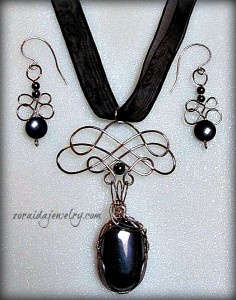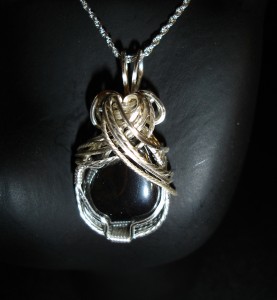- NEW DVD Series – Stone Setting with Bezels
- Tube Set Charm by Kim St. Jean
- Prong Basket Pendant by Kim St. Jean
- NEW DVD Series – Stone Setting with Cold Connections
- New DVD Series – Stone Setting with Wire
- NEW DVD Series: Introduction to Stone Setting by Kim St. Jean
- Featured Tool: Bracelet Bending Plier
- NEW Dvd by Eva Sherman
- Fun, Fast Fold Forming DVD Series
- Double Band Ear Cuff from Alex Simkin
Gem Profile Sept. 28: About Hematite
by Rose Marion, Wire-Sculpture.com

Hematite
Shop Hematite Cabochons | Shop Hematite Beads
Hematite is a primary source of iron, and iron does a big job: it’s found in blood, cars, jewelry, makeup, ink, paint, and spoons. Only a portion of iron turns into jewelry – and although you can find it in many stones, including turquoise, peridot, and sapphire, the stone that contains the most iron is hematite.
Hematite is derived from the Greek word for blood, “haima,” because it is found as a blood-red stone. Hematite is red for the same reason our blood is red: it’s oxygen reacting with iron, in hemoglobin. The stone hematite is a silvery-gray-black color, highly reflective – and in some cases, it’s weakly attracted to a magnet.

Monica Padin wrapped this hematite puffy heart and matching earrings in gold filled and sterling silver wire, then accented with Swarovski crystals.
Hematite in History
Shaped hematite was used as weights in the ancient Mediterranean and Mesopotamian cultures, around 2000-1000 BC. Sometimes the hematite was just formed in a cylinder or sphere, but sometimes it was carved into animals, such as a frog or a duck (see a frog weight in the Metropolitan Museum’s collection here – and here are some from the British Museum, from Ur). Hematite was also carved into seals and beads.
Ishpeming, Michigan, was a town that had active iron ore mines in the 1950s and 1960s, and guess the what their mascot is for the Ishpeming schools? The Hematites!
Hematite hasn’t only been found on Earth: it’s been discovered on Mars by the Opportunity rover. While this doesn’t indicate there was life on Mars, it indicates that there was water, since analysis suggests the hematite formed from a water solution reacting with iron in the soil.
Hematite Uses Outside the Jewelry World
If you dabble in painting as well as jewelry, you’re familiar with ochre. Red ochre contains unhydrated hematite, and hydrated hematite makes up yellow ochre.
In the machinery world, hematite is processed into iron, which is processed into steel, which is processed into cars, forks, knives and spoons, and machinery. Ground hematite is also used in cosmetics, inks, and polishing compounds.
Real Hematite, Manmade Hematite, and Magnetite
Real hematite is extremely rare and highly expensive, and usually not suitable for bead drilling or cabbing in its natural form. Therefore, most beads and cabs on the market sold as hematite are simulated, or else formed from ground hematite dust. Manmade hematite is still made out of iron oxide in most cases. Components labeled “magnetic hematite” are typically manmade, and these are even more magnetic than natural hematite, which only has a weak magnetic draw. You may see names like “hemalyke,” “hematine,” and “hemalike” labeling the manmade hematite. Most beads are not magnetic, but some may be attracted to a magnet.
Hematite might be confused with magnetite, which is also an iron oxide, and in some cases, called lodestone. This form of iron oxide can be naturally magnetic, much more so than hematite. In some forms of manmade hematite, the hematite powder is mixed with magnetite for additional potency. So while manmade hematite is not very natural, it still has a base in nature.

Hematite cabochon wrapped in stainless steel wire by Zoraida Bros, with matching hematite bead earrings.
Hematite Healing Properties
While these are not “straight out of the earth” stones, they are still said to have pain-reducing effects, which is attributed to the magnetic field maintaining the charge of nerve cells. This is why many hematite jewelry pieces are said to help with arthritis, chronic pain, and aching joints.
In ancient times, hematite was believed to stop blood flow from a wound, and was used in amulets relating to female health.
Just a reminder, Wire-Sculpture does not make any claim as to medical or beneficial properties of any of its stones.
Next Friday’s Gem Profile is on magnesite. Have you made wire jewelry with magnesite beads or cabochons before? Dyed magnesite counts! Send your magnesite pictures to tips@wire-sculpture.com, and they could be featured!
Resources & Recommended Reading
- Magnetic Hematite Information
- Magnetic Hematite on MinDat.org
- Elemental Minerals of Mineral Make-up
- Uses of Rocks & Minerals
- Metropolitan Museum Hematite
- Hematite on MinDat.org
- Hematite on Wikipedia
Gem Profile by Rose Marion
Click to Receive Daily Tips by Email






















zoraida
September 28, 2012 at 6:13 am
I love your gem profiles!! I’ve learned so much from them. I knew very little about hematite but noticed differences in the appearance of stones labeled “hematite”. I usually buy my stones at gem & mineral shows so hopefully I’m getting the stones I want.
Thanks so much for the education and for featuring my necklace/earring set:))
Zoraida
Rose
September 28, 2012 at 9:25 am
You’re welcome, Zoraida, I’m so glad you find the gem profiles helpful!
Brenda Sigafoos
September 28, 2012 at 7:08 pm
Rose Here In Brainerd Mn 15 miles away is he Cuyuna range mind pits very famous the Iron oar mine pits for a 100 years I have a rare real Hemitite that i got from the science museum in crosby they study gems, and minerial. I have some pictures of the red roads from the mines and i can take more pictures They are believed to be the first mine pits in the country.
tbeary
September 29, 2012 at 6:54 am
I look forward to the jem profiles. I enjoy having an insite on the material I’m working with. Thank You
Joan Kraus
September 29, 2012 at 6:03 pm
I’ve been concerned about using hematite and its man made brothers because my husband has a pacemaker. I know I cannot use magnetic clasps around him, but what about hematite?
Brenda Verghese
September 30, 2012 at 1:31 pm
YOur information on Gemstones is so informative. Thank you so much